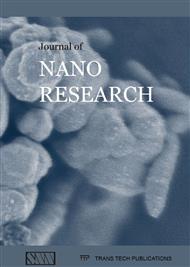[1]
S.R. Chauhan, Kali Dass and Bharti Gaur, (2012).
Google Scholar
[2]
B. Suresha, Kunigal and N. Shiva kumar, (2009), Investigation on mechanical and two body abrasive wear behavior of glass/ carbon fabric reinforced vinyl ester composite, Materials and Design, Vol. 30, pp.2056-206.
DOI: 10.1016/j.matdes.2008.08.038
Google Scholar
[3]
Mahmood M. Shokriek and Majid Jamal Omidi, (2009), Compressive response of glass fiber reinforced polymeric composites to increasing the compressive strain rates, Composite structures, Vol. 89, pp.515-523.
DOI: 10.1016/j.compstruct.2008.11.006
Google Scholar
[4]
Zhanhu Guo, Xiaofeng Liang, Tony Pereira and H. Thomas Hahm, (2007), CuO nano particles filled vinyl ester resin nanocomposites: Fabrication, characterization and property analysis, Composites Science and Technology, Vol, 67, p.2036-(2044).
DOI: 10.1016/j.compscitech.2006.11.017
Google Scholar
[5]
J. Li and L.Q. Zhang, (2009), The addition of carbon nano tubes on the tensile properties of carbon fiber reinforced peek composites, Polymer-Plastic Technology and Engineering, Vol. 48(11), pp.1176-1179.
DOI: 10.1080/03602550903147346
Google Scholar
[6]
K. Sabeel Ahmed, Syed Sha Khalid, V. Mallinatha and S.J. Amith Kumar, (2012), Dry sliding wear behavior of SiC/Al2O3 filled jute/ epoxy composites, , Materials and Design, Vol. 36, pp.306-315.
DOI: 10.1016/j.matdes.2011.11.010
Google Scholar
[7]
Ali Nazari and Shadi Riahi, (2011), The effects of TiO2 nanoparticles on flexural damage of self-compacting concrete, International Journal of Damage Mechanics, Vol. 20, pp.1049-1072.
DOI: 10.1177/1056789510385262
Google Scholar
[8]
Gheorghe Rusu and Elena Rusu, (2012), Anionic nylon 6/ TiO2 composite materials: Effects of TiO2 filler on the thermal and mechanical behavior of the composites, Polymer Composites, Vol. 33, p.1557–1569.
DOI: 10.1002/pc.22292
Google Scholar
[9]
K.V. Arun, D. Sujay Kumar, M.C. Murugesh, (2014), Influence of bolt configuration and TiO2 /ZnS fillers content on the strength of composites fasteners,. Materials & Design Vol. 53, pp.51-57.
DOI: 10.1016/j.matdes.2013.06.008
Google Scholar
[10]
Haider Ali Hussen, (2014), Experimental investigation for TiO2 nanoparticles as a lubricant additive for a compressor of window type air-conditioner system, Journal of Engineering, Vol. 20(2), pp.61-72.
DOI: 10.31026/j.eng.2014.02.05
Google Scholar
[11]
Bernd Wetzel, Patrick Rosso, Frank Haupert and Klaus Friedrich, (2006), "Epoxy nanocomposites-fracture and toughening mechanisms, Engineering Fracture Mechanics, Vol. 73, Issue 16, pp.2375-2398.
DOI: 10.1016/j.engfracmech.2006.05.018
Google Scholar
[12]
S. Nallusamy and A. Manoj Babu, (2015), Investigation on carbon nanotubes over review on other heat transfer nano fluids, International Journal of Applied Engineering Research, Vol. 10(62), pp.112-117.
Google Scholar
[13]
Sher Bahadar Khan et al, (2012), Copper oxide based polymer nanohybrid for chemical sensor applications, Int. Journal of Electro chemical Science, Vol. 7, pp.10965-10975.
Google Scholar
[14]
S. Nallusamy and A. Manoj Babu, (2015), X-Ray differaction and FESEM analysis for mixture of hybrid nano particles in heat transfer applications, Journal of Nano Research, Vol. 37, pp.58-67.
DOI: 10.4028/www.scientific.net/jnanor.37.58
Google Scholar
[15]
Asama. N. Naje et al, (2013), Preparation and characterization of SnO2 nanoparticles, Int. l Journal of Innovative Research in Science, Engg. and Tech., Vol. 2, Issue 12, pp.7068-7072.
Google Scholar
[16]
N. Selvi and S. Sankar, (2014), Effect of shells ZnO; SiO2 on SnO2 hybrid core-shell nanospheres and their structural, morphological and magnetic properties, International Journal of Chemical Technology Research, Vol. 6, No. 14, pp.5665-5671.
DOI: 10.1016/j.spmi.2014.10.015
Google Scholar
[17]
M.W. Kusmono, Wildan and Z.A. Mohd Ishak, (2013), Preparation and Properties of Clay-Reinforced Epoxy Nanocomposites, International Journal of Polymer Science Vol. 201, pp.01-07.
DOI: 10.1155/2013/690675
Google Scholar


